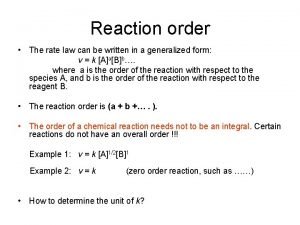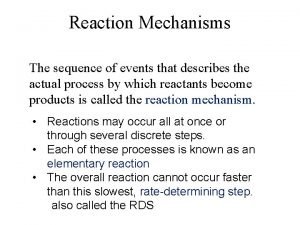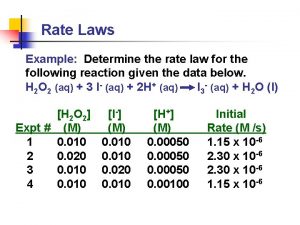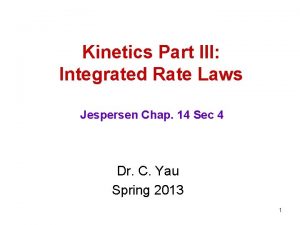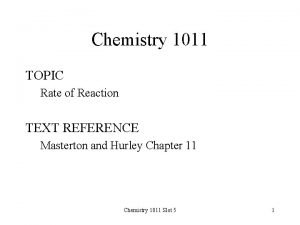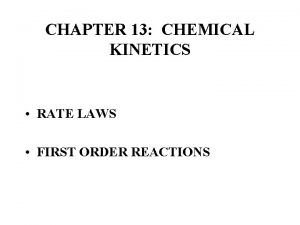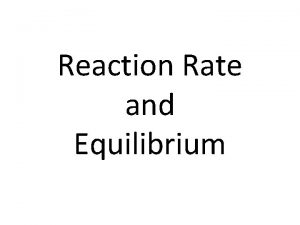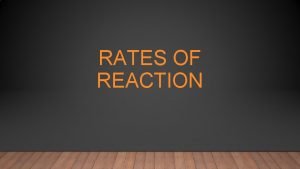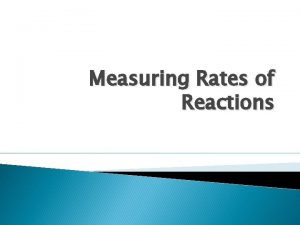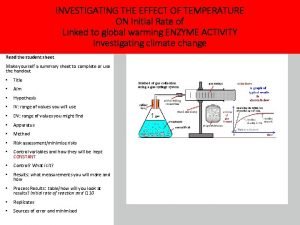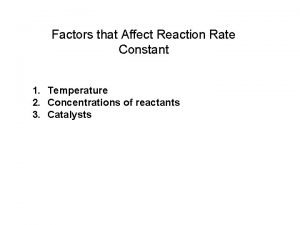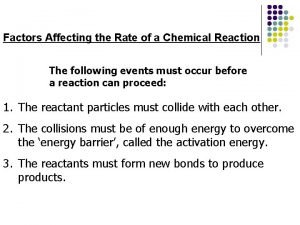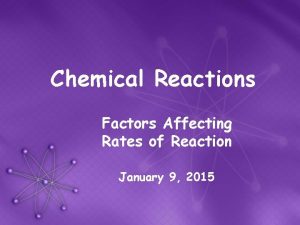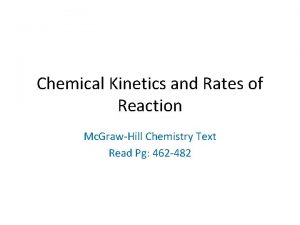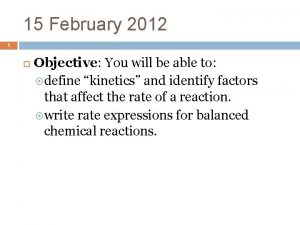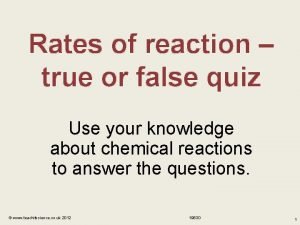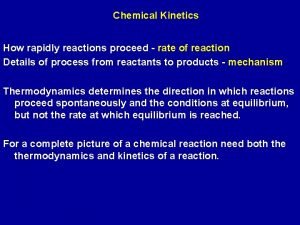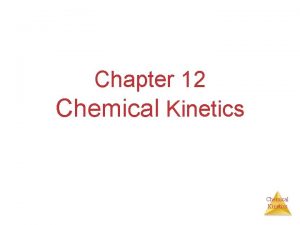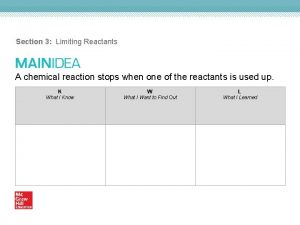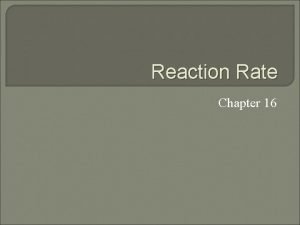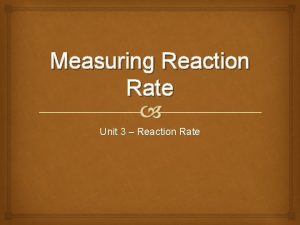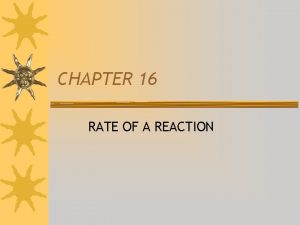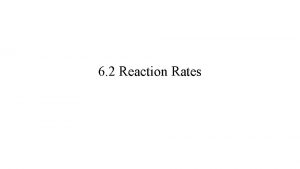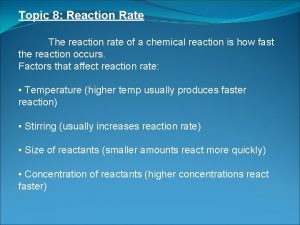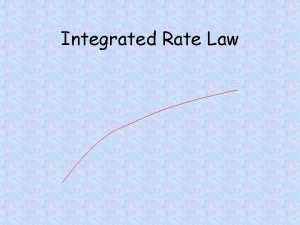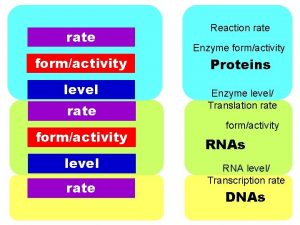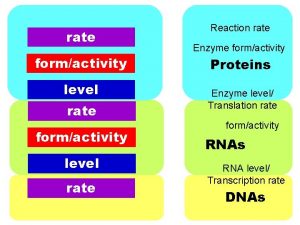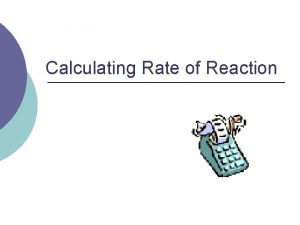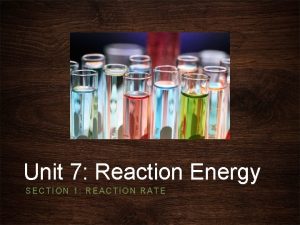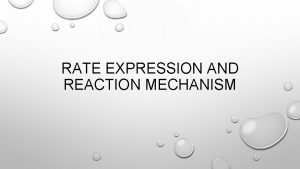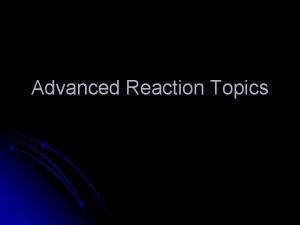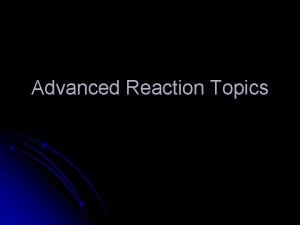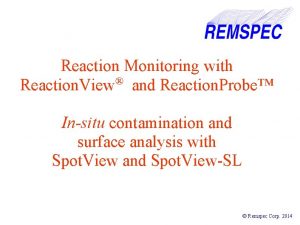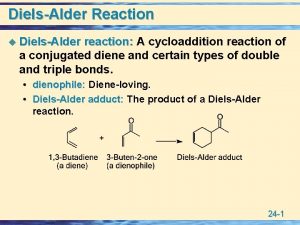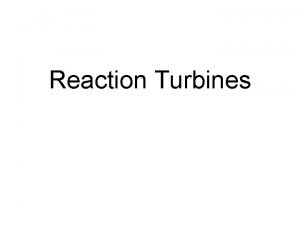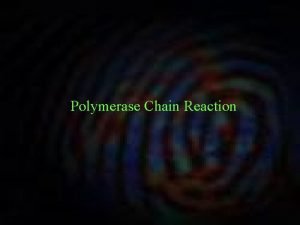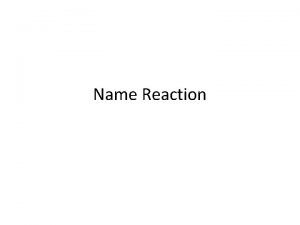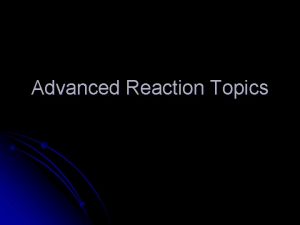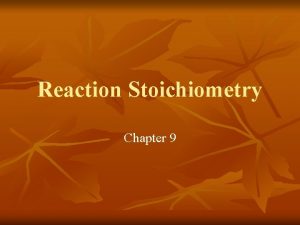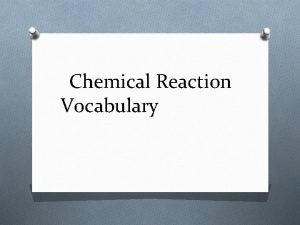Section 16 3 Reaction Rate Law Rate law






![Rate = k[A]m[B]n Reaction order = m + n If Rate = k [A]1[B]0 Rate = k[A]m[B]n Reaction order = m + n If Rate = k [A]1[B]0](https://slidetodoc.com/presentation_image_h2/ab0f0862d5093301cda26780ba3a280f/image-7.jpg)



















- Slides: 26

Section 16. 3 Reaction Rate Law

Rate law Specific rate constant Reaction order Method of initial rates

Rate = k(conc x A) k is a Rate constant It is a numerical value that relates the reaction rate and the concentrations of reactants at a given temperature. The power(x) is the order of the reaction.

Rate = k(conc x A) • If “X" = 0, the reaction is zero order • If “X" = 1, it is first order • If “X" = 2, it is second order The order of the reaction expresses the relationship between the rate of a chemical reaction and the concentration of the reactants.

If( x) = 0 the reaction is zero order – rate is independent of the concentration. no effect on rate If x = 1: the reaction is first order - rate is directly proportional to the concentration of the reactant. Doubling the concentration increases the rate by a factor of 2. Doubling the concentration , doubles the rate of the reaction

1 6. 3 SECTION Reaction Rate Laws The specific rate constant( k ) is unique for every reaction. The unit for expressing a rate is mol /L ● s
![Rate kAmBn Reaction order m n If Rate k A1B0 Rate = k[A]m[B]n Reaction order = m + n If Rate = k [A]1[B]0](https://slidetodoc.com/presentation_image_h2/ab0f0862d5093301cda26780ba3a280f/image-7.jpg)
Rate = k[A]m[B]n Reaction order = m + n If Rate = k [A]1[B]0 = k [A] Then the reaction is 1 st order in [A] and 0 th order in [B] 1+0 = The reaction is 1 st order.

Find the order of the reaction Example: CO + NO 2 -----> CO 2 + NO rate = k(conc CO)m(conc NO 2)n The coefficient of CO=1 The coefficient of NO 2 =1 First order with respect to CO, m = 1 First order with respect to NO 2, n = 1 second order overall, m + n = 2

1 6. 3 SECTION Reaction Rate Laws Writing Reaction Rate Laws • A rate law expresses the relationship between the rate of a chemical reaction and the concentration of the reactants.

1 6. 3 SECTION Reaction Rate Laws Writing Reaction Rate Laws (cont. ) • The symbol k is the specific rate constant, a numerical value that relates the reaction rate and the concentrations of reactants at a given temperature. • The specific rate constant is unique for every reaction.

1 6. 3 SECTION Reaction Rate Laws Writing Reaction Rate Laws (cont. ) • The reaction order for a reactant defines how the rate is affected by the concentration of that reactant. • Rate = k[H 2 O 2] • The reaction is first order, so the rate changes in the same proportion the concentration of H 2 O 2 changes.

1 6. 3 SECTION Reaction Rate Laws Writing Reaction Rate Laws (cont. ) • 2 NO(g) + 2 H 2(g) → N 2(g) + 2 H 2(g) –Rate = k[NO]2[H 2] –If H 2 is doubled, the rate doubles. –If NO is doubled, the rate quadruples because 22 = 4. –First-order H 2, second-order NO, third-order overall

1 6. 3 SECTION Reaction Rate Laws Determining Reaction Order • The method of initial rates determines reaction order by comparing the initial rates of a reaction carried out with varying reactant concentrations. • Initial rate measures how fast the reaction proceeds at the moment when reactants are mixed.

1 6. 3 SECTION Reaction Rate Laws Determining Reaction Order (cont. )

Method of initial rates Find the order of the reaction for the experiment Rate = k[A]m[B]n Compare the concentrations and reaction rates in trials 1 and 2 you can see when you double the concentration the rate is twice that in trial 1. 2 = k[2]m The order of the reaction must equal 1. so [2]1 = 2 Trials 2 and 3 you can see when you double the concentration the rate increased by four times. [2]m = 4 m must = 2 [2]2 =4 This reaction is 1 st order in A and 2 nd order in B The overall reaction is third order (sum 2+1=3) Rate = k[A]1[B]2

1 6. 3 SECTION Reaction Rate Laws Determining Reaction Order (cont. ) • Doubling [A] doubles the reaction rate, so [A] is first order. • Doubling [B] quadruples the reaction rate, so [B] is second order. • Rate = k[A][B]2

See your notebook for the answer.

1 6. 3 SECTION Section Check What is the overall reaction order of the following reaction? Rate = k[A]2[B]2 A. 1 st B. 2 nd C. 3 rd D. 4 th

1 6. 3 SECTION Section Check In the following reaction, what is the overall reaction order if doubling [A] results in quadrupling the reaction rate and doubling [B] results in a reaction rate eight times faster? Rate = k[A]m[B]n A. 12 B. 5 C. 6 D. 10

See your notebook for the answer.

Reaction Rate Laws 1 6. 3 SECTION Study Guide Key Concepts • The mathematical relationship between the rate of a chemical reaction at a given temperature and the concentrations of reactants is called the rate law. rate = k[A]m[B]n • The rate law for a chemical reaction is determined experimentally using the method of initial rates.

1 6. 3 SECTION Section Check What is the overall reaction order of the following reaction? Rate = k[A]2[B]2 A. 1 st B. 2 nd C. 3 rd D. 4 th

1 6. 3 SECTION Section Check In the following reaction, what is the overall reaction order if doubling [A] results in quadrupling the reaction rate and doubling [B] results in a reaction rate eight times faster? Rate = k[A]m[B]n A. 12 B. 5 C. 6 D. 10

CHAPTER 16 Reaction Rates Chapter Assessment What is the overall reaction order of the following reaction? Rate = k[A][B]2[C] A. 1 st order B. 2 nd order C. 3 rd order D. 4 th order

CHAPTER 16 Reaction Rates Standardized Test Practice Doubling the concentration of one reactant in a reaction causes the reaction rate to double. What is the order of that reactant? A. 1 st B. 2 nd C. unable to determine D. none of the above

CHAPTER 16 Reaction Rates Standardized Test Practice The rate law for the reaction A + B + C → Product is rate = k[A]2[B][C]. If [A] = 0. 350 M, [B] =. 500 M, [C] =. 125 M, and k = 6. 50 × 10– 5 L 3/(mol 3 ● s), what is the instantaneous rate of reaction? A. 2. 84 × 10– 6 mol/L ● s B. 4. 98 × 10– 7 mol/L ● s C. 5. 84 × 10– 6 mol/L ● s D. 2. 84 × 10– 7 mol/L ● s
 Reaction rate equation
Reaction rate equation Elementary reaction
Elementary reaction Overall rate law of a reaction
Overall rate law of a reaction Rate law
Rate law Laws jespersen
Laws jespersen Overall rate law of a reaction
Overall rate law of a reaction Rate=k a b
Rate=k a b E1cb elimination reaction
E1cb elimination reaction Leukoerythroblastic reaction vs leukemoid reaction
Leukoerythroblastic reaction vs leukemoid reaction Proton capture equation
Proton capture equation Equilibrium reaction rate
Equilibrium reaction rate How to calculate rate of reaction
How to calculate rate of reaction How to calculate the instantaneous rate of reaction
How to calculate the instantaneous rate of reaction Investigate a factor affecting the initial rate of reaction
Investigate a factor affecting the initial rate of reaction Factors affecting rate constant
Factors affecting rate constant Factors affecting rate of chemical reaction
Factors affecting rate of chemical reaction What is catalyst and how it affects reaction rate
What is catalyst and how it affects reaction rate Maxwell boltzmann distribution catalyst
Maxwell boltzmann distribution catalyst Half life for second order reaction
Half life for second order reaction Activation energy and temperature
Activation energy and temperature How to write reaction rate
How to write reaction rate Rate of reaction quiz
Rate of reaction quiz Surface area affecting rate of reaction
Surface area affecting rate of reaction Reaction rate and stoichiometry
Reaction rate and stoichiometry Reactants leftover when a reaction stops are
Reactants leftover when a reaction stops are Newton's first law and second law and third law
Newton's first law and second law and third law Newton's first law
Newton's first law

